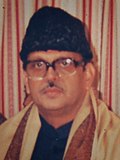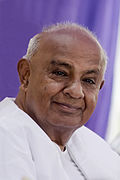Top Qs
Timeline
Chat
Perspective
Janata Dal
Former political party in India, 1988–1999 From Wikipedia, the free encyclopedia
Remove ads
Janata Dal (lit. 'People's Party') was an Indian political party which was formed through the merger of Lok Dal, Jagiivan's Congress, and Jan Morcha on 11 October 1988—the birth anniversary of Jayaprakash Narayan under the leadership of V. P. Singh.[3][4]
Remove ads
History
V. P. Singh united the entire disparate spectrum of parties ranging from regional parties such as the Telugu Desam Party, the Dravida Munnetra Kazhagam, and the Asom Gana Parishad, and formed the National Front with N. T. Rama Rao as President and Singh as convenor. The front also included outside support from the right-wing Bharatiya Janata Party and the left-wing Left Front, led by the Communist Party of India and Communist Party of India (Marxist). They defeated Rajiv Gandhi's Congress (I) in the 1989 parliamentary elections.[5][6] His government fell after Lalu Prasad Yadav got Advani arrested in Samastipur and stopped his Ram Rath Yatra, which was going to Ayodhya to the site of the Babri Masjid on 23 October 1990, and the Bharatiya Janata Party withdrew support. Singh lost a parliamentary vote of confidence on 7 November 1990.[7] In the 1991 Indian general election the Janata Dal lost power but emerged as the third largest party in the Lok Sabha.[8] The Janata Dal-led United Front formed the government after the 1996 Indian general election with the outside support of the Indian National Congress. However, after this the Janata Dal gradually disintegrated into various smaller factions, which largely became regional parties such as Biju Janata Dal, Rashtriya Janata Dal, Janata Dal (Secular) and Janata Dal (United).[9]
Remove ads
Ascent to power
Summarize
Perspective

It first came to power in 1989, after cases of corruption, known as the Bofors scandal, caused Rajiv Gandhi's Congress (I) to lose the elections. The National Front coalition that was formed consisted of the Janata Dal and a few smaller parties in the government, and had outside support from the Left Front and the Bharatiya Janata Party. V. P. Singh was the prime minister. In November 1990, this coalition collapsed, and a new government headed by Chandra Shekhar under Samajwadi Janata Party (Rashtriya) which had the support of the Congress came to power for a short while. Two days before the vote, Chandra Shekhar, an ambitious Janata Dal rival who had been kept out of the National Front government, joined with Devi Lal, a former deputy prime minister under V. P. Singh, to form the Samajwadi Janata Party, with a total of sixty Lok Sabha members. The day after the collapse of the National Front government, Chandra Shekhar informed the president that by gaining the backing of the Congress (I) and its electoral allies he enjoyed the support of 280 members of the Lok Sabha, and he demanded the right to constitute a new government. Even though his rump party accounted for only one-ninth of the members of the Lok Sabha, Chandra Shekhar succeeded in forming a new minority Government and becoming prime minister (with Devi Lal as deputy prime minister). However, Chandra Shekhar's government fell less than four months later, after the Congress (I) withdrew its support.[10]

Its second spell of power began in 1996, when the Janata Dal-led United Front coalition came to power, with outside support from the Congress under Sitaram Kesri, choosing H. D. Deve Gowda as their prime minister. The Congress withdrew its support in less than a year, after the Deve Gowda Government restarted probing the corruption cases against a lot of Congress leaders, hoping to gain power with the support of various United Front constituent groups, and I. K. Gujral became the next prime minister. His government too fell in a few months, and in February 1998, the Janata Dal-led coalition lost power to the Bharatiya Janata Party in general elections.[citation needed]
Remove ads
Party presidents
National leadership
Vice president
Prime minister
Deputy Prime Minister of India
Remove ads
State leadership
Chief minister
Deputy chief minister
Remove ads
Electoral records
National and state units

- National general secretary[11]
State units
- Uttar Pradesh
Anantram Jaiswal (1983)
- Karnataka
Presidents
B. Rachaiah (1989)[12]
Siddaramaiah (Feb 1999)[13]
C. Byre Gowda (July 1999)[14]
General secretary
Jeevaraj Alva (1989-1990)[15][12]
C. Narayanaswamy (1999)[14]
- Tamil Nadu
- President
Sivaji Ganesan (1989–1993)
Factions
Summarize
Perspective
Defunct parties
- Jan Adhikar Party (Loktantrik) led by Pappu Yadav (merged with Indian National Congress).
- Samajwadi Janata Party (Rashtriya) of Late Chandra Shekhar is now defunct because of weak leadership.
- Samajwadi Janata Dal (Democratic) led by Devendra Prasad Yadav (merged with Rashtriya Janata Dal).
- Bharatiya Sablog Party led by Arun Kumar (merged with Lok Janshakti Party (Ram Vilas)).
- Lok Janshakti Party of Late Ram Vilas Paswan and led by Chirag Paswan (split into the Lok Janshakti Party (Ram Vilas) led by Ram's son Chirag Paswan, and the Rashtriya Lok Janshakti Party led by Ram's brother Pashupati Kumar Paras).
- Rashtriya Lok Samta Party led by Upendra Kushwaha (merged with Janata Dal United).
- Loktantrik Janata Dal led by Late Sharad Yadav (merged with Rashtriya Janata Dal).
- Socialist Janata Party led by Manju Mohan (merged with Socialist Party (India)).
- Samras Samaj Party led by Nagmani (merged with Rashtriya Lok Samta Party).[17]
- Samata Party of Late George Fernandes (merged with Janata Dal (United)).
- Socialist Janata (Democratic) led by Late M. P. Veerendra Kumar (merged with Janata Dal (United))[18][19]
- Jan Morcha of Late V. P. Singh and led by Ajeya Pratap Singh (merged with Indian National Congress).
- Odisha Jan Morcha is defunct because of weak leadership.
- Odisha Gana Parishad led by Bijoy Mohapatra (merged with Nationalist Congress Party).
- All India Progressive Janata Dal led by Late Ramakrishna Hegde and late S. R. Bommai (merged with Janata Dal (United)).
- Janata Dal (Left) led by Late Surendra Mohan and Late M. P. Veerendra Kumar (merged with Janata Dal (Secular)).
- Lok Shakti led by Late Ramakrishna Hegde (merged with Janata Dal (United)).
- Pragatisheel Samajwadi Party (Lohiya) led by Shivpal Singh Yadav (merged with Samajwadi Party).
- Janata Dal (Gujarat) led by Late Chimanbhai Patel and Late Chhabildas Mehta (merged with Indian National Congress).
- Janata Dal (Digvijay) led by Digvijay Singh (merged with Bharatiya Janata Party).
- Janata Dal (Ajit) led by Late Ajit Singh (merged with Indian National Congress).
- Janata Dal (Socialist) led by Late Chandra Shekhar, Late Devi Lal, Late Mulayam Singh Yadav (renamed as Late Samajwadi Janata Party (Rashtriya)).
- Punjab Janata Morcha (PJM), in English the Punjab Popular Front, was a Sikh political party in the Indian state of Punjab. The party formed in 1989 as a splinter group of the Janata Dal. The party failed to win any election seats in its lifetime. Party president Kirpal Singh announced that the PJM was disbanded in 1997. Most members joined the Jan Morcha by 2003.[20]
Remove ads
See also
References
Wikiwand - on
Seamless Wikipedia browsing. On steroids.
Remove ads















